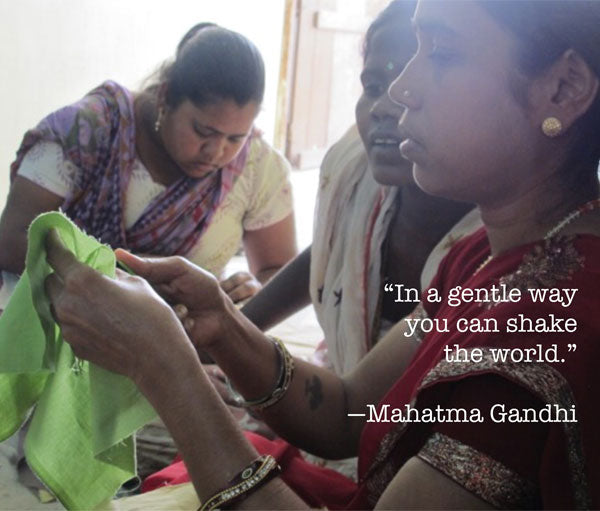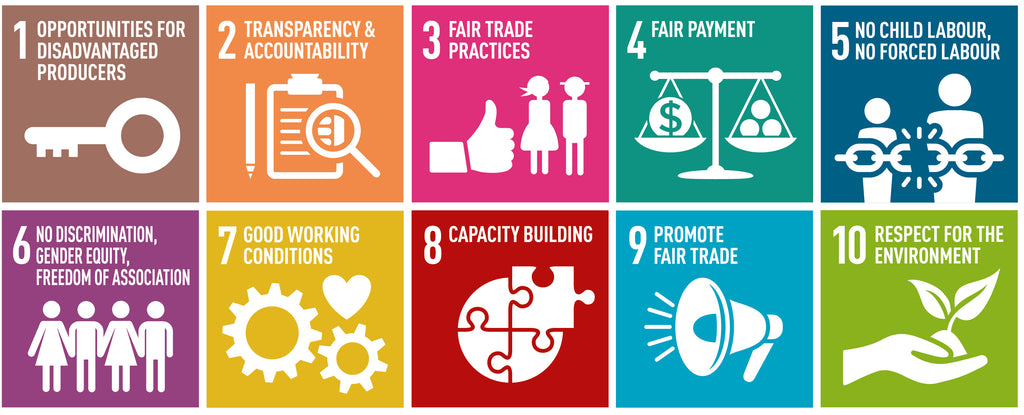
Environment - People - Design
Mehera Shaw is committed to becoming as sustainable as possible throughout our manufacturing supply chain. We realize that sustainably has multiple, interwoven areas and to ignore any one area is to overlook the deeper meaning. To sustain something means to support it in a way that is ongoing; to continually renew, regenerate and breathe life into something. We use the term to refer to the life-supporting and interconnected relationships between:
- people
- environment
- design
Sustainability is far more than removing pollutants from the garment supply chain.
Sustainability requires understanding the supply chain as a living circle that includes farmers, workers, artisans, buyers, and consumers, as well as our human and natural environment.
Ultimately, sustainability is about keeping the whole system in balance so that we all have — enough.
What We Have Achieved So Far
The 'People' Part of Sustainability
We work with artisans and take inspiration from Gandhi’s principles of self-reliance: when workers are empowered, we become stronger together.
We work toward building transparent, supportive networks within our supply chain in order to maintain both fair trade labor standards and a high-quality standard in our raw materials. Our supply chain choices and decision-making process prioritizes people first.
Within our own company, all decisions prioritize people first and uphold our commitment to fair trade standards. Sustaining our employees through fair trade labor standards is our top priority.
What is Fair Trade at Mehera Shaw?
We are a fair trade, ethical manufacturer based in Jaipur, India, and an artisanal lifestyle brand, based in Chapel Hill, NC, USA. We are members of the WFTO (World Fair Trade Organization - number 1047). We are dedicated to manufacturing high-quality clothing and homewares based on a business philosophy that puts the human factor first. Fair trade labor standards include:
- no discrimination
- no forced labor
- payment of a living wage, all staff are full-time salaried employees
- on-time payments to employees and suppliers
- clean and safe working conditions
- no excessive working hours
- no forced overtime
- no child labor
- pension funds for all employees
- working in a supportive, transparent way throughout the supply chain.

The 'Planet' Part of Sustainability
We work to protect the environment at each step in our manufacturing process by removing pollutants, reducing energy and resource usage, minimizing waste, and finding systems that renew the land, water, and natural environment.
To reduce pollutants we use:
- GOTS certified organic cotton in 95% of our manufacturing.
- fiber reactive, low-impact dyes which are AZO free and heavy metal free.
- hydrogen peroxide for whitening rather than chlorine bleach.
- handloom fabrics, source almost all of our fabrics from India and work directly with local block printers as much as possible to reduce our carbon footprint.
- wastewater filtration and water recycling (for more information see our Clean Water 4 Artisans page)
The ‘Design’ Part of Sustainability
Sustainable Design allows those who made it to live decently and those who wear it to be an active part of that human story. It is not only fashionable, it is the only road to sustainability.
We believe Sustainable Design is vitally important to sustainable production. It takes into consideration:
- the purpose of the product (We believe in making everyday wear that will be used regularly, rather than special occasion wear that may only be used a couple of times before its lifecycle is completed.)
- quality of workmanship (We believe quality is synonymous with long use and better for the environment.)
- the wearability/longevity of a garment (We believe garments/products should be designed for maximum wearability/usability to get the most life out of the product.)
- the scale of production and the resulting economics (We believe in minimizing excess in the fashion industry and keeping production minimums to reasonable limits that work together with the scale of a human-centered business model.)
- politics of production (We believe good design is also about practicality; we source what is readily available, and understand that sustainability is a continually evolving process rather than a series of black-and-white benchmarks and unrealistic sourcing demands that are very often 'unsustainable.')
- and economics of production (We believe good design takes into consideration affordability, accessibility, and consumer demographics.)
The Significance of Sustainable Design
Sustainable Design sits within a complex web of interconnections -- how we create a product, perceive it, and use it.
Sustainable Design takes into consideration the global supply chain and strives to:
- reduce pressure on developing countries to produce at below cost.
- find transparent, practical, accountable, and environmentally better solutions to sourcing raw materials
- use less packaging
- avoid order cancellation and raw material dumping
- develop ways to reuse, recycle and upcycle
- send a message to end consumers about design, wearability, transparency and their role in the lifecycle of a product
Sustainable Design and Slow Fashion
Sustainable design embraces the aesthetics and goals of slow fashion. It is about moving away from trends and changing the idea of fashion as a commodity. It is about moving away from the social pressure to be ‘in’ and moving toward a human connectedness and desire to ensure that everyone has –enough.
Sustainable design is not trendy; it is practical, wearable, and becomes more beautiful the longer its story is told. So-called sustainable fashion, which appears as one-time evening gowns is not sustainable.
Slow fashion is an aesthetic that embraces creativity, personal expression, and moderation in consumption. It is about seeing clothing not as a means toward securing popularity, but as a means of telling the human story of the many hands who made it, the human story that brings all of us together. It is about valuing the longevity of every garment, and learning to mend, share, recycle, and upcycle.
Slow fashion puts human beings first and recognizes that we can’t couple words like “organic,” “fair trade,” and “artisan” with “sustainability” until we rethink what type of fashion we’re producing, what type of designs, at what speed, with what longevity, and what marketing message.
Slow fashion is an intrinsic part of the road to sustainability and addresses the core principles of ethical fashion. It is a different understanding of art, design, process, durability, longevity and the human story—encoded in the garment.
We'd like to share an article by Camilla Wellton on Slow Fashion which addresses the core values of this movement and further addresses how we must work together toward sustainable solutions.
Camilla Wellton article on slow fashion
Practical Steps Toward Sustainability
We work to coordinate our use of environmentally sound raw materials, sourcing, and manufacturing practices with fair trade labor standards and sustainable design as a three-pronged approach to practical sustainability. We also recognize that sustainability is an evolving process, a road we are taking, and a path with continual room for improvement. Sustainability is not black-and-white. We strive to continually improve while being conscious of the fine balance between all three facets.
Below we have outlined the benefits of all three facets - people, planet, and design.
Benefits of Fair Trade
- ensures worker rights
- ensures a living wage
- minimizes environmental footprint
- supports artisans
- supports cultural identity
- supports heritage crafts and artisan traditions
- minimizes the supply chain length by removing middlemen, allowing artisans to speak for themselves
- provides long-term income security which enables long-term family sustainability
Benefits of Fair Trade
WFTO fair trade principles
Benefits of Organic Cotton
- It’s better for the environment.
- Growing techniques use less water, maintain soil fertility and build biologically diverse agriculture
- There is no use of pesticides, insecticides, herbicides, and genetically modified organisms which are toxic and harmful to both farmers and consumers and the wildlife ecosystem.
- Biological means are used to control pests.
- Crop rotation is used to replenish the soil.
- Manual and organic farming practices lower the carbon footprint and allow the renewal of the entire ecosystem.
- India is the world's largest organic cotton producer. In an effort to support India’s farmers, we source all of our organic cotton from India.
- Both improved social conditions in organic farming in India and avoiding the use of expensive pesticides helps farmers out of the cycle of debt and poverty.
- Manufacturers of certified organic cotton are required to meet international labor standards regarding minimum wage, child labor, discrimination, working hours (http://www.global-standard.org/the-standard.html)
- It avoids GMOs (genetically modified organisms) which pose a potential risk to human health worldwide and increase expenses associated with farming.
- The end garments are free from pesticides and other toxic residues used in conventional cotton production.
For more information on organic cotton standards, please see the links below:
Benefits of Low-Impact Dyes
- less harmful to the environment
- less harmful to human health: both for garment workers and consumers
- reduces water consumption, particularly in water scare areas such as Jaipur, India
GOTS information about compliant dyestuff
Benefits of Handloom (Khadi) Textiles
- supports India’s artisans
- shortens the supply chain
- reduces carbon footprint through hand production
- promoted skills training for India’s artisan
- supports Gandhi’s concept of decentralized, small-scale production for India’s rural artisans
- protects heritage crafts through Government of India financial assistance for skills training, looms, infrastructure for artisans
- promotes cooperative societies to improve the social and financial situation of India’s artisans
- supports women artisans in skills up-gradation and increased livelihood generation
- promotes handloom weavers’ health insurance and welfare schemes available through Government of India programs (Government of India Khadi initiative)
- provides government-supported access to markets, financial assistance
Please see the link below for more information on the Government of India, Ministry of Textiles report on handloom textiles and benefits for Indian artisans:
Textile Ministry of India Annual Report
Benefits of Hand Block Printing
- promotes small-scale, decentralized production
- maintains cultural identity
- preserves a national heritage craft of India
- supports artisan work and skills up-gradation
- promotes cross-cultural understanding
- reduces the carbon footprint in textile printing
- reduces energy consumption
- shortens the supply chain and promotes positive supply chain relationships
Benefits of Upcycling
- skills up-gradation for women artisans
- supports women's empowerment
- reduction of post-production scrap fabric waste into upcycled, valued product
- part of a zero-water garment lifecycle
Benefits of Sustainable Design
- less waste
- improved supply chain equity
- more end-consumer involvement
- improved garment lifecycle
- less product being thrown into landfills
- more thoughtful consumer habits
Roadmap for the Future
Our Long-Term Goals Include
- a more developed water filtration for our dyeing and printing unit
- using solar energy for all CMT manufacturing and dyeing work
- rainwater harvesting and permaculture gardening to minimize water usage and invest in soil renewal
- more employee benefits: creche, further skills upgradation, regular artisan training sessions
- formation of cooperative artisan groups for block printers, women artisans
- growing our business and spreading the message of ethical manufacturing
- improve transparency through every portion of the supply chain
- hosting workshops so that customers can experience and engage in the big picture
- improve upcycling program to support women's development






